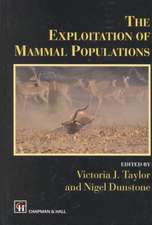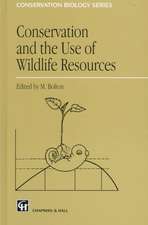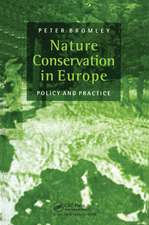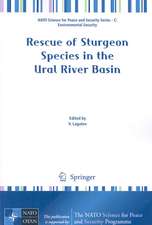Butterfly Conservation in North America: Efforts to help save our charismatic microfauna
Editat de Jaret C Danielsen Limba Engleză Hardback – 7 aug 2015
Impacts from habitat loss and fragmentation, invasive species, and climate change continue to accelerate the rate of imperilment and necessitate increased conservation action.
Zoos, natural history museums, botanical gardens and wildlife agencies are progressively focusing on insects, particularly charismatic groups such as butterflies and native pollinators, to help advance local conservation efforts and foster increased community interest and engagement.
Today, many institutions and their partners have successfully initiated at-risk butterfly conservation programs, and numerous others are exploring ways to become involved. However, insufficient experience and familiarity with insects is a critical constraint preventing staff and institutions from adequately planning, implementing and evaluating organism-targeted activities.
The information provided is intended to improve staff practices, learn from existing programs, promote broader information exchange, and strengthen institutional ability to develop new or improve existing butterfly conservation initiatives.
The information provided is intended to improve staff practices, learn from existing programs, promote broader information exchange, and strengthen institutional ability to develop new or improve existing butterfly conservation initiatives. This book will be useful to professionals from zoos, natural history museums, botanical gardens, wildlife agencies, conservation organizations, land managers, students, and scientist in conservation biology, ecology, entomology, biology, and zoology.
| Toate formatele și edițiile | Preț | Express |
|---|---|---|
| Paperback (1) | 466.52 lei 38-44 zile | |
| SPRINGER NETHERLANDS – 23 oct 2016 | 466.52 lei 38-44 zile | |
| Hardback (1) | 644.49 lei 3-5 săpt. | |
| SPRINGER NETHERLANDS – 7 aug 2015 | 644.49 lei 3-5 săpt. |
Preț: 644.49 lei
Preț vechi: 758.23 lei
-15% Nou
Puncte Express: 967
Preț estimativ în valută:
123.34€ • 127.42$ • 102.65£
123.34€ • 127.42$ • 102.65£
Carte disponibilă
Livrare economică 04-18 martie
Preluare comenzi: 021 569.72.76
Specificații
ISBN-13: 9789401798518
ISBN-10: 9401798516
Pagini: 260
Ilustrații: VII, 192 p. 33 illus., 20 illus. in color.
Dimensiuni: 155 x 235 x 15 mm
Greutate: 0.53 kg
Ediția:1st ed. 2015
Editura: SPRINGER NETHERLANDS
Colecția Springer
Locul publicării:Dordrecht, Netherlands
ISBN-10: 9401798516
Pagini: 260
Ilustrații: VII, 192 p. 33 illus., 20 illus. in color.
Dimensiuni: 155 x 235 x 15 mm
Greutate: 0.53 kg
Ediția:1st ed. 2015
Editura: SPRINGER NETHERLANDS
Colecția Springer
Locul publicării:Dordrecht, Netherlands
Public țintă
Professional/practitionerCuprins
Butterfly Recovery Planning: Determining How to Contribute.- The Role of AZA-Accredited Zoos and Aquariums in Butterfly Conservation.- Butterfly Monitoring for Conservation.- Developing a Rare Butterfly Database for Conservation Purposes: An Example in Florida Using Citizen Scientists.- Butterfly Conservation Genetics.- Managing Land for Butterflies.- The Imperiled Mardon Skipper Butterfly: An Initial Conservation Success.- Habitat Restoration as a Recovery Tool for a Disturbance-dependent Butterfly, The Endangered St. Francis’ Satyr.- Butterflies are Not Grizzly Bears: Lepidoptera Conservation in Practice in California.
Recenzii
“The contributions in this edited volume constitute a highly practical guide to obtaining critical information about imperiled butterflies and strategies for implementing their conservation. … each chapter is focused on a particular aspect of butterfly conservation, or is a case study of the conservation of particular species or a species in a specific geographic region. … This book is a must for anyone contemplating direct engagement with butterfly conservation activities.” (Chris Nice, The Quarterly Review of Biology, Vol. 91 (3), September, 2016)
“The book accomplished the goal of providing a framework for butterfly conservation and management efforts. … useful for groups interested in identifying ways to best participate in these efforts. For readers not familiar with specific issues associated with imperiled butterflies, the focus on practical applications and numerous case studies provide an excellent starting point for developing relevant programs. Overall, the diverseexpertise and experiences of the authors provide an important resource for practitioners interested in butterfly conservation and management.” (Kristen A. Baum, The Journal of Wildlife Management, Vol. 80 (5), July, 2016)
“Each chapter is referenced independently and also includes a summary of key points discussed. … book fulfills its promise of delivering practical advice to advance butterfly conservation. It is informative and also refreshingly free from excessive ‘jargon’ … . I hope that it will indeed be read widely and its content heeded in planning further conservation efforts for butterflies across North America.” (Tim R. New, Journal of Insect Conservation, Vol. 19, 2015)
“The book accomplished the goal of providing a framework for butterfly conservation and management efforts. … useful for groups interested in identifying ways to best participate in these efforts. For readers not familiar with specific issues associated with imperiled butterflies, the focus on practical applications and numerous case studies provide an excellent starting point for developing relevant programs. Overall, the diverseexpertise and experiences of the authors provide an important resource for practitioners interested in butterfly conservation and management.” (Kristen A. Baum, The Journal of Wildlife Management, Vol. 80 (5), July, 2016)
“Each chapter is referenced independently and also includes a summary of key points discussed. … book fulfills its promise of delivering practical advice to advance butterfly conservation. It is informative and also refreshingly free from excessive ‘jargon’ … . I hope that it will indeed be read widely and its content heeded in planning further conservation efforts for butterflies across North America.” (Tim R. New, Journal of Insect Conservation, Vol. 19, 2015)
Textul de pe ultima copertă
This book is intended to serve as a basic primer for practitioners interested in working with butterflies. The various chapters provide a combination of specific case studies and broader overviews of key issues relating to research, habitat restoration, captive propagation, population monitoring, and stakeholder education and training. Butterflies are experiencing declines worldwide. Prompted by this trend, interest in at-risk butterfly conservation has grown tremendously in recent years, as has the number of dedicated recovery initiatives. Zoos, natural history museums, botanical gardens, and state and federal wildlife agencies are progressively focusing on insects, particularly charismatic groups such as butterflies and pollinators, to help advance local conservation efforts and foster increased public interest and community engagement. However, insufficient experience and familiarity with butterflies can often hinder conservation practitioners from adequately planning, implementing and evaluating essential program components. Determining the best ways to make meaningful contributions to new or ongoing at-risk butterfly recovery initiatives is critical and typically driven by available expertise and resources.
Caracteristici
A useful decision support tool for practitioners to review available options to get involved in butterfly conservation initiatives Informative case studies provide readers with an overview of helpful approaches and lessons learned that can be applied to other at-risk butterflies Includes a step-by-step guide for including genetic data in conservation and management plans Ideal background for practitioners involved in/or developing butterfly conservation programs including wildlife agencies, ZOOs, Natural History Museums or other conservation organizations






















